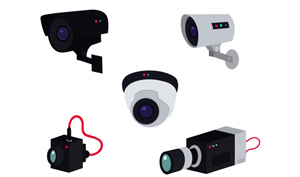The Basic elements of any CCTV camera system
CCTV cameras provide surveillance capabilities used in the protection of people and assets. A CCTV camera installer links the monitor to a video camera using a direct transmission system. Surveillance systems can be extremely simple, a camera lens with a monitor or very complex that use the latest technology. Here are some key elements of all CCTV systems.
Image acquisition of CCTV system installer
The first stage of any surveillance system is the image acquisition stage. It is an action of retrieving an image from the camera. It is the first step in the workflow sequence because processing cannot be done without an image. The image acquired from the camera is completely unprocessed. You can start with a simple camera. It has a chip at the front that transforms the light or infrared into an electrical signal. The incoming energy is transformed into a voltage by the combination of electrical input power and a sensor material that is responsive to the light. The output voltage is the response of the sensor and it is converted into a digital form that can be displayed on the screen.

Add a lens to the camera as it will give you a focused image. Adjust the focal length of the lens so that the field-of-view suits your scene and records the footage as per your preferred details. Photons are required to create the picture. The image acquisition can be done by using a variety of sensors. The motion should be in both x and y directions to obtain a two-dimensional image. The rotation of the camera provides motion in one direction while linear motion provides motion in perpendicular directions. A CCTV camera installer cannot capture good images without sufficient light. Hence, you should ensure that there are no objects in front of the camera lens.
Place a protective casing outside cameras as it will protect them against dust, dirt and rain. A wall bracket with a manually adjustable joint will keep your static camera oriented correctly in any weather. If you want to operate your camera with remote control, you can add a motorised pan and tilt unit between the camera and mounting. As the pan needs to decode the remote-control signals, an elementary receiver will also be needed.
Sturdy mounts such as purpose-built poles or lattice towers are needed for heavy loads. Consider tilt-over type of mounts that will allow you to do fitting and maintenance of the CCTV equipment at ground level.
Signal transmission
As we’ve successfully completed image acquisition, let’s progress to the next part – signal transmission. Video output from the CCTV camera could be:
- IP video as TCP/IP or UDP multicast
- Composite analogue signal
- HD-SDI and High Definition
To produce a good quality picture on the screen, the video signal must be applied to the monitor with no distortion of any of its elements. The camera should be connected to the monitor by using Fibre Optic cable or MicroWave link. Fibre Optic cables will transmit the signal effectively because they have a higher bandwidth and low loss characteristics. The composite video output from the average CCTV camera covers a bandwidth ranging from 5Hz to many MHz’s. Almost all cables produce a loss of signal that is primarily dependent on the frequency. The higher the frequency, the higher the loss. This means that as a video signal travels along a cable it loses its high-frequency components faster than its lower ones. A significant loss of detail is not usually objectionable unless it is very large.
Wireless cameras are alternative to cameras using cables. The wireless transmissions include microwave line-of-sight links and microwaves over short distances. These cameras allow you to access the video footage from your smartphone.
Managing the arrived picture
The video signals from the camera arrive at a CCTV control and monitoring point. Hence, a switcher is necessary to direct the images to the system. Analogue video switchers might be desktop ‘8-in, 1-out’ or ‘128-in, 32-out’ matrix. Sometimes the images are digitised before or after they arrive. Software such as DVR/NVR can be used to switch the images. The output is then transmitted to the display and the recorders. Analogue signals go to the LCD or plasma screens while the digitised signals are fed to displays via the computerised innards of DVR, NVR and Virtual matrix.
The telemetry signals come from the operator’s control keyboard or automatic preset positions triggered by the alarm sensors. As recorders are universally digital these days, you can export the footage to CD, DVD or other portable drives.
